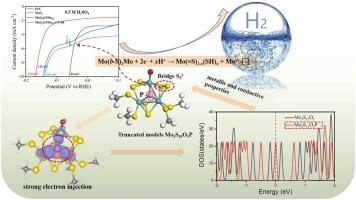揭示了掺磷非晶硫化钼在大电流密度下优越的析氢性能
IF 6.3
2区 材料科学
Q2 CHEMISTRY, PHYSICAL
引用次数: 0
摘要
开发强大的电催化剂,与间歇性风能/太阳能协同作用,驱动高效的析氢反应(HER),对于建立实用的绿色氢基础设施至关重要。在这里,我们报道了一种非晶磷掺杂的MoS2催化剂(P-MoS2),它在工业相关电流下实现了卓越的活性-稳定性协同作用。优化后的催化剂在酸性介质中具有139 mV@10 mA cm-2和279 mV@100 mA cm-2的超低过电位,在200 mA cm-2下具有前所未有的120小时稳定性。DFT计算表明,p掺杂产生了富电子的2S22-活性位点,H*吸附能接近最佳(ΔGH*= -0.08 eV)。至关重要的是,催化剂的无定形性质赋予了它们的动态电荷再分配机制,这确保了在可再生能源系统波动功率输入时稳定的电子供应。这项工作为合理设计工业级电流下HER的高性能催化剂提供了一条途径。本文章由计算机程序翻译,如有差异,请以英文原文为准。

Unveiling the superior hydrogen evolution performance of phosphorus-doped amorphous molybdenum sulfide under large current density
Developing robust electrocatalysts that synergize with intermittent wind/solar power to drive efficient hydrogen evolution reaction (HER) has become critical for establishing practical green hydrogen infrastructure. Here, we report an amorphous phosphorus-doped MoS2 catalyst (P-MoS2) that achieves exceptional activity-stability synergy at industry-relevant current. The optimized catalyst delivers ultralow overpotentials of 139 mV@10 mA cm-2 and 279 mV@100 mA cm-2 in acid medium, with unprecedented 120-hour stability at 200 mA cm-2. DFT calculation reveals that P-doping creates electron-rich 2S22- active sites with near-optimal H* adsorption energy (ΔGH*= -0.08 eV). Crucially, the amorphous nature of catalyst endows their dynamic charge redistribution mechanism, which ensures stable electron supply during fluctuating power inputs characteristic of renewable energy systems. This work provides a route towards rationally designing high-performance catalysts for the HER at industrial-level currents.
求助全文
通过发布文献求助,成功后即可免费获取论文全文。
去求助
来源期刊

Journal of Alloys and Compounds
工程技术-材料科学:综合
CiteScore
11.10
自引率
14.50%
发文量
5146
审稿时长
67 days
期刊介绍:
The Journal of Alloys and Compounds is intended to serve as an international medium for the publication of work on solid materials comprising compounds as well as alloys. Its great strength lies in the diversity of discipline which it encompasses, drawing together results from materials science, solid-state chemistry and physics.
 求助内容:
求助内容: 应助结果提醒方式:
应助结果提醒方式:


